Creative Negotiations in Public-Private Business Deals Analysis
VerifiedAdded on 2020/05/28
|15
|3752
|103
Report
AI Summary
This report examines creative negotiations in public-private business deals and decision-making within Abu Dhabi, focusing on the emirate's economic diversification efforts. It explores the role of public-private partnerships (PPPs) in Abu Dhabi's business sector, analyzing the current economic conditions and the potential benefits of PPPs. The report includes a literature review of relevant studies on PPPs, examining factors influencing their success in the UAE and globally. It also outlines the research questions, objectives, and methodology used to analyze the role of creative negotiations. The report aims to understand how PPPs contribute to business development and decision-making processes in Abu Dhabi, considering both the public and private sectors' perspectives. The report discusses the importance of partnerships between the public and private sectors in promoting economic growth, emphasizing the role of Abu Dhabi's government in fostering entrepreneurship and high-value industries. Finally, the report addresses the need for creative negotiation strategies to facilitate successful business deals between public and private entities in Abu Dhabi.
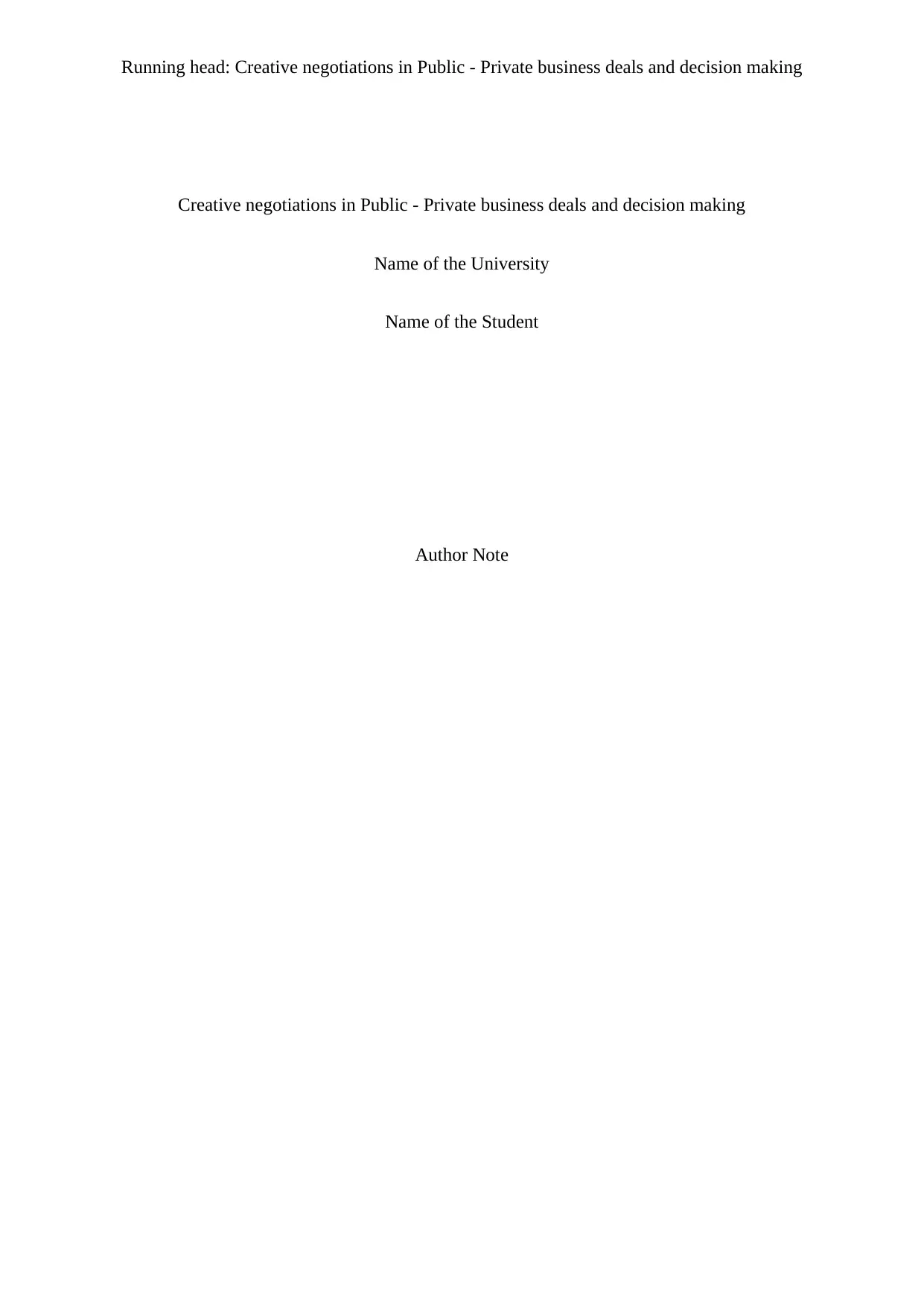
Running head: Creative negotiations in Public - Private business deals and decision making
Creative negotiations in Public - Private business deals and decision making
Name of the University
Name of the Student
Author Note
Creative negotiations in Public - Private business deals and decision making
Name of the University
Name of the Student
Author Note
Paraphrase This Document
Need a fresh take? Get an instant paraphrase of this document with our AI Paraphraser
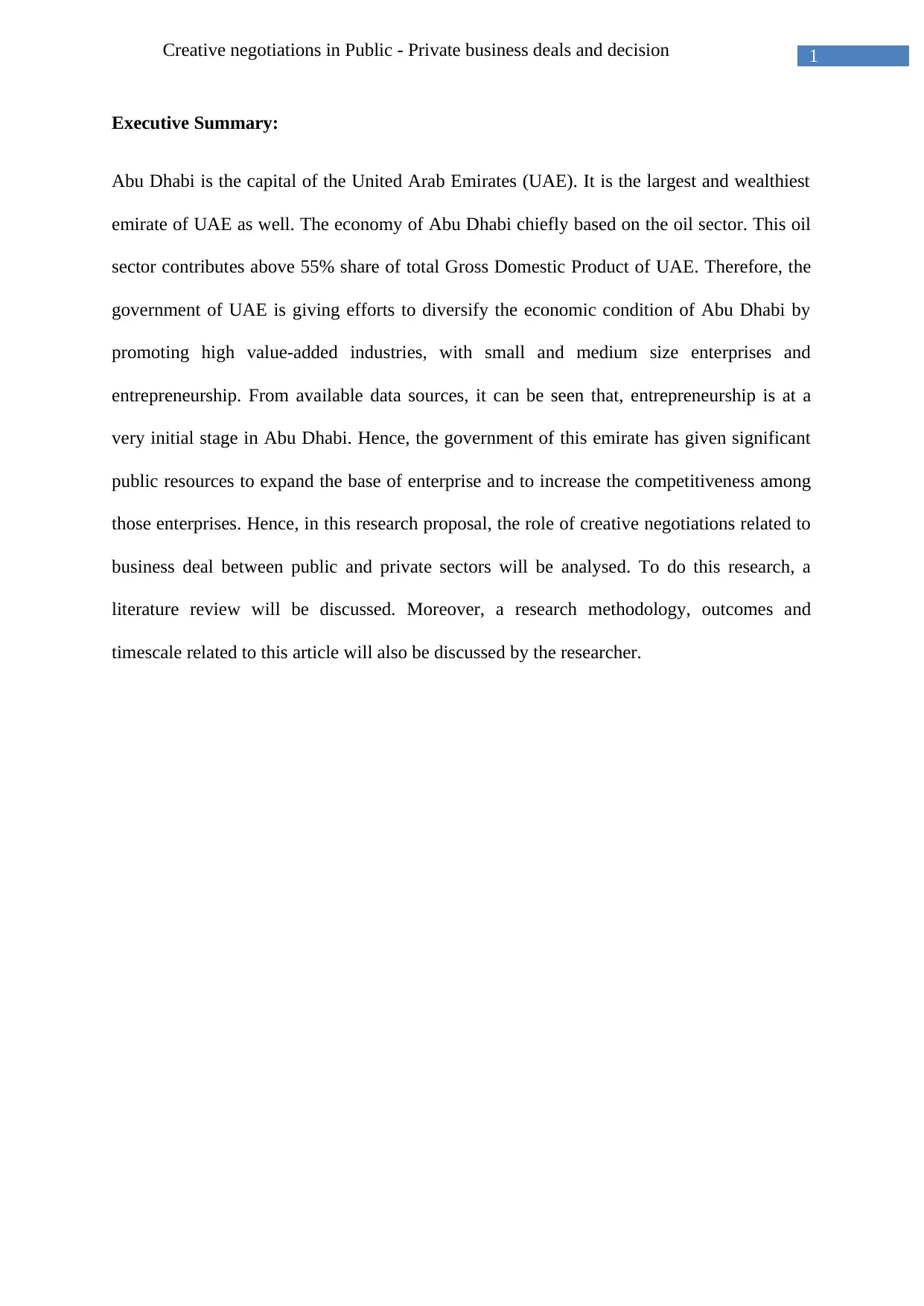
1Creative negotiations in Public - Private business deals and decision
making
Executive Summary:
Abu Dhabi is the capital of the United Arab Emirates (UAE). It is the largest and wealthiest
emirate of UAE as well. The economy of Abu Dhabi chiefly based on the oil sector. This oil
sector contributes above 55% share of total Gross Domestic Product of UAE. Therefore, the
government of UAE is giving efforts to diversify the economic condition of Abu Dhabi by
promoting high value-added industries, with small and medium size enterprises and
entrepreneurship. From available data sources, it can be seen that, entrepreneurship is at a
very initial stage in Abu Dhabi. Hence, the government of this emirate has given significant
public resources to expand the base of enterprise and to increase the competitiveness among
those enterprises. Hence, in this research proposal, the role of creative negotiations related to
business deal between public and private sectors will be analysed. To do this research, a
literature review will be discussed. Moreover, a research methodology, outcomes and
timescale related to this article will also be discussed by the researcher.
making
Executive Summary:
Abu Dhabi is the capital of the United Arab Emirates (UAE). It is the largest and wealthiest
emirate of UAE as well. The economy of Abu Dhabi chiefly based on the oil sector. This oil
sector contributes above 55% share of total Gross Domestic Product of UAE. Therefore, the
government of UAE is giving efforts to diversify the economic condition of Abu Dhabi by
promoting high value-added industries, with small and medium size enterprises and
entrepreneurship. From available data sources, it can be seen that, entrepreneurship is at a
very initial stage in Abu Dhabi. Hence, the government of this emirate has given significant
public resources to expand the base of enterprise and to increase the competitiveness among
those enterprises. Hence, in this research proposal, the role of creative negotiations related to
business deal between public and private sectors will be analysed. To do this research, a
literature review will be discussed. Moreover, a research methodology, outcomes and
timescale related to this article will also be discussed by the researcher.
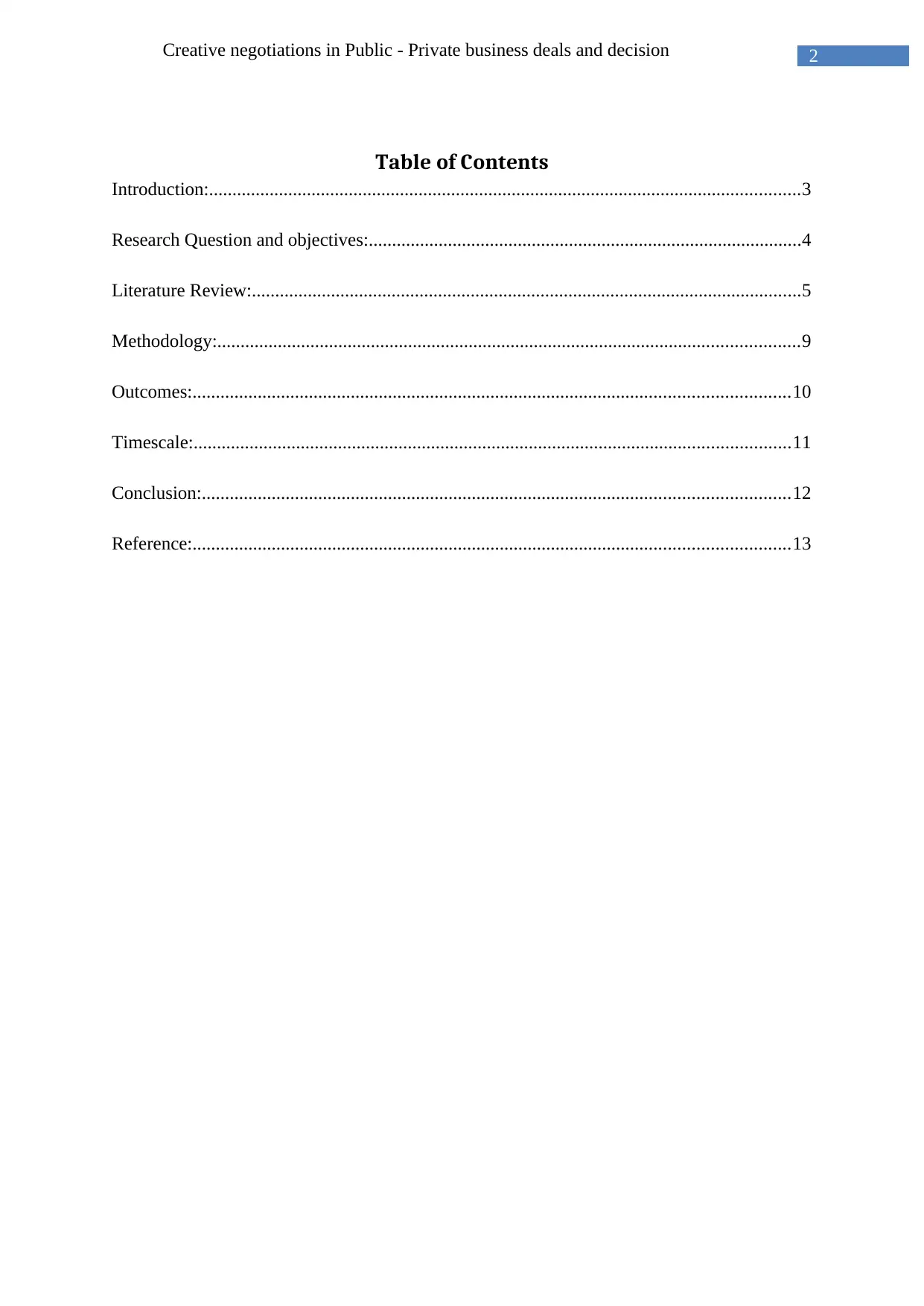
2Creative negotiations in Public - Private business deals and decision
making
Table of Contents
Introduction:...............................................................................................................................3
Research Question and objectives:.............................................................................................4
Literature Review:......................................................................................................................5
Methodology:.............................................................................................................................9
Outcomes:................................................................................................................................10
Timescale:................................................................................................................................11
Conclusion:..............................................................................................................................12
Reference:................................................................................................................................13
making
Table of Contents
Introduction:...............................................................................................................................3
Research Question and objectives:.............................................................................................4
Literature Review:......................................................................................................................5
Methodology:.............................................................................................................................9
Outcomes:................................................................................................................................10
Timescale:................................................................................................................................11
Conclusion:..............................................................................................................................12
Reference:................................................................................................................................13
⊘ This is a preview!⊘
Do you want full access?
Subscribe today to unlock all pages.

Trusted by 1+ million students worldwide
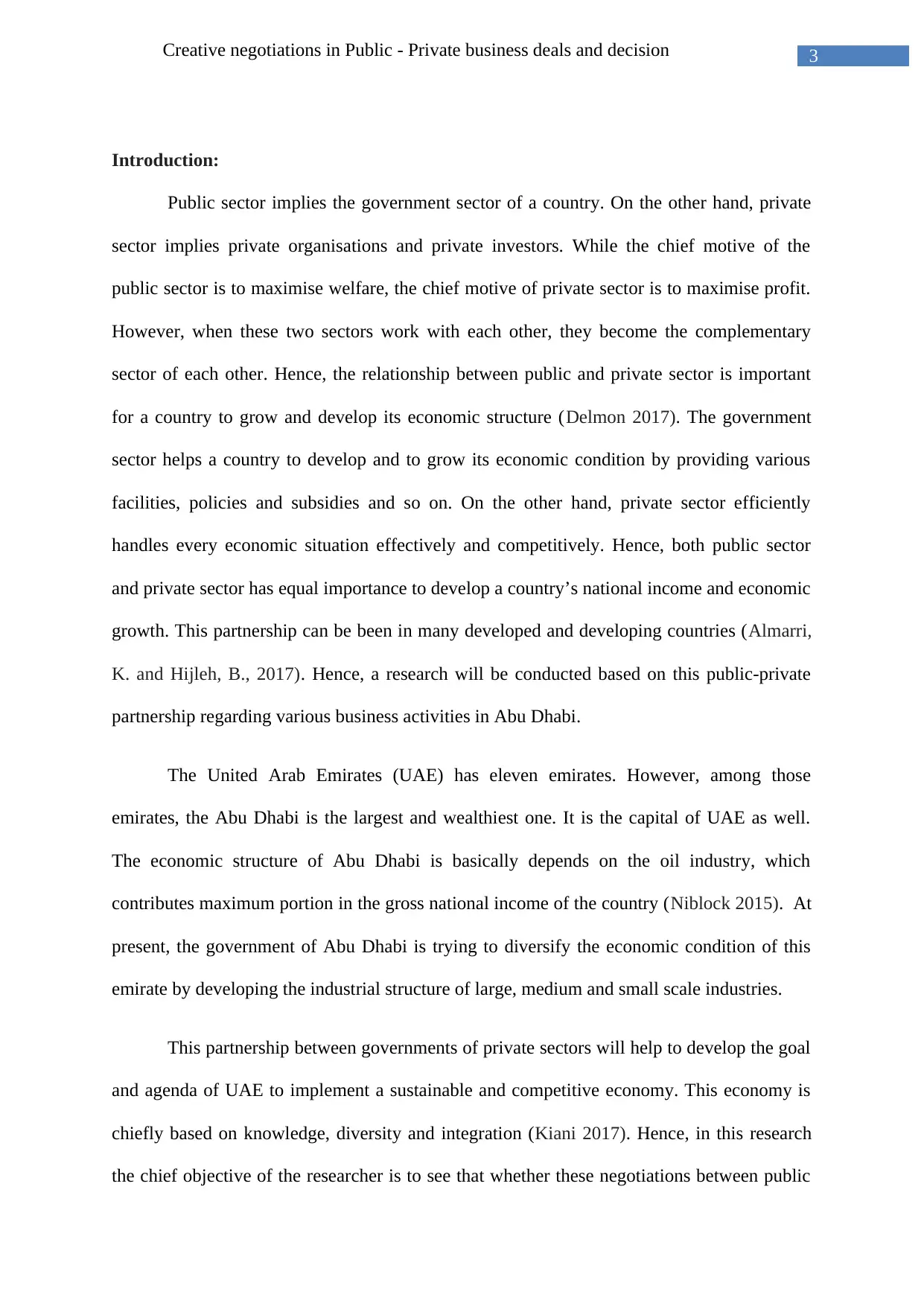
3Creative negotiations in Public - Private business deals and decision
making
Introduction:
Public sector implies the government sector of a country. On the other hand, private
sector implies private organisations and private investors. While the chief motive of the
public sector is to maximise welfare, the chief motive of private sector is to maximise profit.
However, when these two sectors work with each other, they become the complementary
sector of each other. Hence, the relationship between public and private sector is important
for a country to grow and develop its economic structure (Delmon 2017). The government
sector helps a country to develop and to grow its economic condition by providing various
facilities, policies and subsidies and so on. On the other hand, private sector efficiently
handles every economic situation effectively and competitively. Hence, both public sector
and private sector has equal importance to develop a country’s national income and economic
growth. This partnership can be been in many developed and developing countries (Almarri,
K. and Hijleh, B., 2017). Hence, a research will be conducted based on this public-private
partnership regarding various business activities in Abu Dhabi.
The United Arab Emirates (UAE) has eleven emirates. However, among those
emirates, the Abu Dhabi is the largest and wealthiest one. It is the capital of UAE as well.
The economic structure of Abu Dhabi is basically depends on the oil industry, which
contributes maximum portion in the gross national income of the country (Niblock 2015). At
present, the government of Abu Dhabi is trying to diversify the economic condition of this
emirate by developing the industrial structure of large, medium and small scale industries.
This partnership between governments of private sectors will help to develop the goal
and agenda of UAE to implement a sustainable and competitive economy. This economy is
chiefly based on knowledge, diversity and integration (Kiani 2017). Hence, in this research
the chief objective of the researcher is to see that whether these negotiations between public
making
Introduction:
Public sector implies the government sector of a country. On the other hand, private
sector implies private organisations and private investors. While the chief motive of the
public sector is to maximise welfare, the chief motive of private sector is to maximise profit.
However, when these two sectors work with each other, they become the complementary
sector of each other. Hence, the relationship between public and private sector is important
for a country to grow and develop its economic structure (Delmon 2017). The government
sector helps a country to develop and to grow its economic condition by providing various
facilities, policies and subsidies and so on. On the other hand, private sector efficiently
handles every economic situation effectively and competitively. Hence, both public sector
and private sector has equal importance to develop a country’s national income and economic
growth. This partnership can be been in many developed and developing countries (Almarri,
K. and Hijleh, B., 2017). Hence, a research will be conducted based on this public-private
partnership regarding various business activities in Abu Dhabi.
The United Arab Emirates (UAE) has eleven emirates. However, among those
emirates, the Abu Dhabi is the largest and wealthiest one. It is the capital of UAE as well.
The economic structure of Abu Dhabi is basically depends on the oil industry, which
contributes maximum portion in the gross national income of the country (Niblock 2015). At
present, the government of Abu Dhabi is trying to diversify the economic condition of this
emirate by developing the industrial structure of large, medium and small scale industries.
This partnership between governments of private sectors will help to develop the goal
and agenda of UAE to implement a sustainable and competitive economy. This economy is
chiefly based on knowledge, diversity and integration (Kiani 2017). Hence, in this research
the chief objective of the researcher is to see that whether these negotiations between public
Paraphrase This Document
Need a fresh take? Get an instant paraphrase of this document with our AI Paraphraser
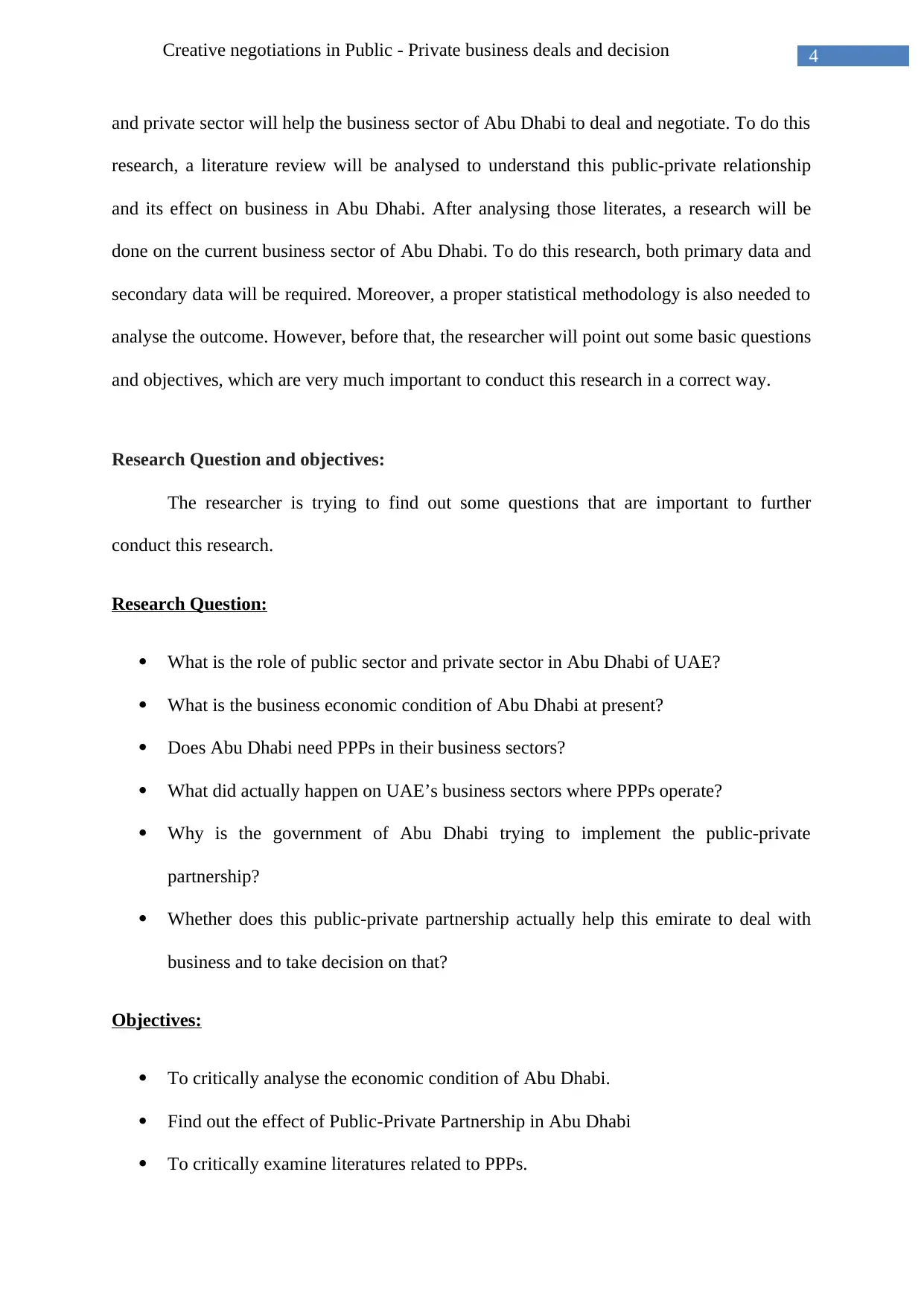
4Creative negotiations in Public - Private business deals and decision
making
and private sector will help the business sector of Abu Dhabi to deal and negotiate. To do this
research, a literature review will be analysed to understand this public-private relationship
and its effect on business in Abu Dhabi. After analysing those literates, a research will be
done on the current business sector of Abu Dhabi. To do this research, both primary data and
secondary data will be required. Moreover, a proper statistical methodology is also needed to
analyse the outcome. However, before that, the researcher will point out some basic questions
and objectives, which are very much important to conduct this research in a correct way.
Research Question and objectives:
The researcher is trying to find out some questions that are important to further
conduct this research.
Research Question:
What is the role of public sector and private sector in Abu Dhabi of UAE?
What is the business economic condition of Abu Dhabi at present?
Does Abu Dhabi need PPPs in their business sectors?
What did actually happen on UAE’s business sectors where PPPs operate?
Why is the government of Abu Dhabi trying to implement the public-private
partnership?
Whether does this public-private partnership actually help this emirate to deal with
business and to take decision on that?
Objectives:
To critically analyse the economic condition of Abu Dhabi.
Find out the effect of Public-Private Partnership in Abu Dhabi
To critically examine literatures related to PPPs.
making
and private sector will help the business sector of Abu Dhabi to deal and negotiate. To do this
research, a literature review will be analysed to understand this public-private relationship
and its effect on business in Abu Dhabi. After analysing those literates, a research will be
done on the current business sector of Abu Dhabi. To do this research, both primary data and
secondary data will be required. Moreover, a proper statistical methodology is also needed to
analyse the outcome. However, before that, the researcher will point out some basic questions
and objectives, which are very much important to conduct this research in a correct way.
Research Question and objectives:
The researcher is trying to find out some questions that are important to further
conduct this research.
Research Question:
What is the role of public sector and private sector in Abu Dhabi of UAE?
What is the business economic condition of Abu Dhabi at present?
Does Abu Dhabi need PPPs in their business sectors?
What did actually happen on UAE’s business sectors where PPPs operate?
Why is the government of Abu Dhabi trying to implement the public-private
partnership?
Whether does this public-private partnership actually help this emirate to deal with
business and to take decision on that?
Objectives:
To critically analyse the economic condition of Abu Dhabi.
Find out the effect of Public-Private Partnership in Abu Dhabi
To critically examine literatures related to PPPs.
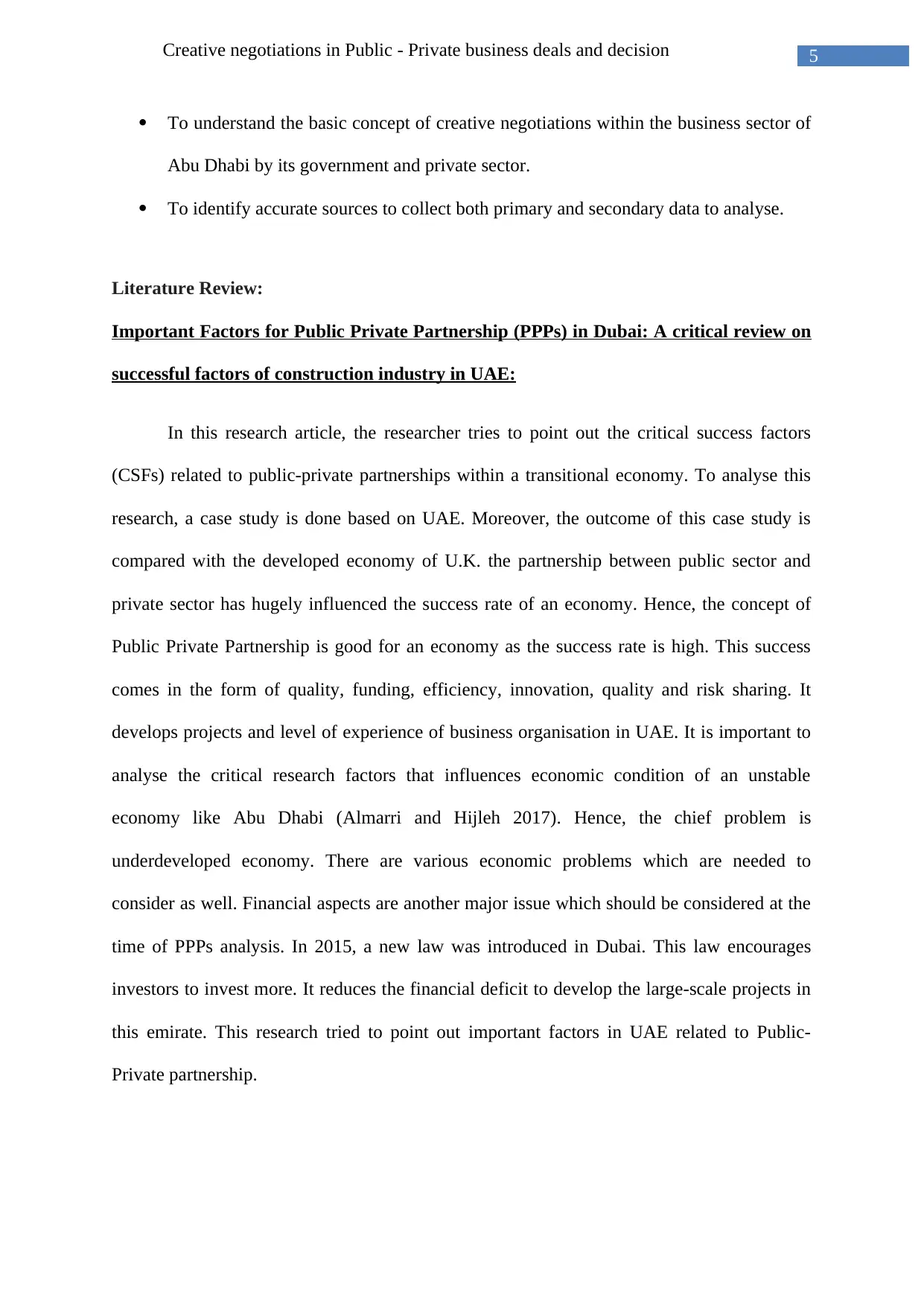
5Creative negotiations in Public - Private business deals and decision
making
To understand the basic concept of creative negotiations within the business sector of
Abu Dhabi by its government and private sector.
To identify accurate sources to collect both primary and secondary data to analyse.
Literature Review:
Important Factors for Public Private Partnership (PPPs) in Dubai: A critical review on
successful factors of construction industry in UAE:
In this research article, the researcher tries to point out the critical success factors
(CSFs) related to public-private partnerships within a transitional economy. To analyse this
research, a case study is done based on UAE. Moreover, the outcome of this case study is
compared with the developed economy of U.K. the partnership between public sector and
private sector has hugely influenced the success rate of an economy. Hence, the concept of
Public Private Partnership is good for an economy as the success rate is high. This success
comes in the form of quality, funding, efficiency, innovation, quality and risk sharing. It
develops projects and level of experience of business organisation in UAE. It is important to
analyse the critical research factors that influences economic condition of an unstable
economy like Abu Dhabi (Almarri and Hijleh 2017). Hence, the chief problem is
underdeveloped economy. There are various economic problems which are needed to
consider as well. Financial aspects are another major issue which should be considered at the
time of PPPs analysis. In 2015, a new law was introduced in Dubai. This law encourages
investors to invest more. It reduces the financial deficit to develop the large-scale projects in
this emirate. This research tried to point out important factors in UAE related to Public-
Private partnership.
making
To understand the basic concept of creative negotiations within the business sector of
Abu Dhabi by its government and private sector.
To identify accurate sources to collect both primary and secondary data to analyse.
Literature Review:
Important Factors for Public Private Partnership (PPPs) in Dubai: A critical review on
successful factors of construction industry in UAE:
In this research article, the researcher tries to point out the critical success factors
(CSFs) related to public-private partnerships within a transitional economy. To analyse this
research, a case study is done based on UAE. Moreover, the outcome of this case study is
compared with the developed economy of U.K. the partnership between public sector and
private sector has hugely influenced the success rate of an economy. Hence, the concept of
Public Private Partnership is good for an economy as the success rate is high. This success
comes in the form of quality, funding, efficiency, innovation, quality and risk sharing. It
develops projects and level of experience of business organisation in UAE. It is important to
analyse the critical research factors that influences economic condition of an unstable
economy like Abu Dhabi (Almarri and Hijleh 2017). Hence, the chief problem is
underdeveloped economy. There are various economic problems which are needed to
consider as well. Financial aspects are another major issue which should be considered at the
time of PPPs analysis. In 2015, a new law was introduced in Dubai. This law encourages
investors to invest more. It reduces the financial deficit to develop the large-scale projects in
this emirate. This research tried to point out important factors in UAE related to Public-
Private partnership.
⊘ This is a preview!⊘
Do you want full access?
Subscribe today to unlock all pages.

Trusted by 1+ million students worldwide
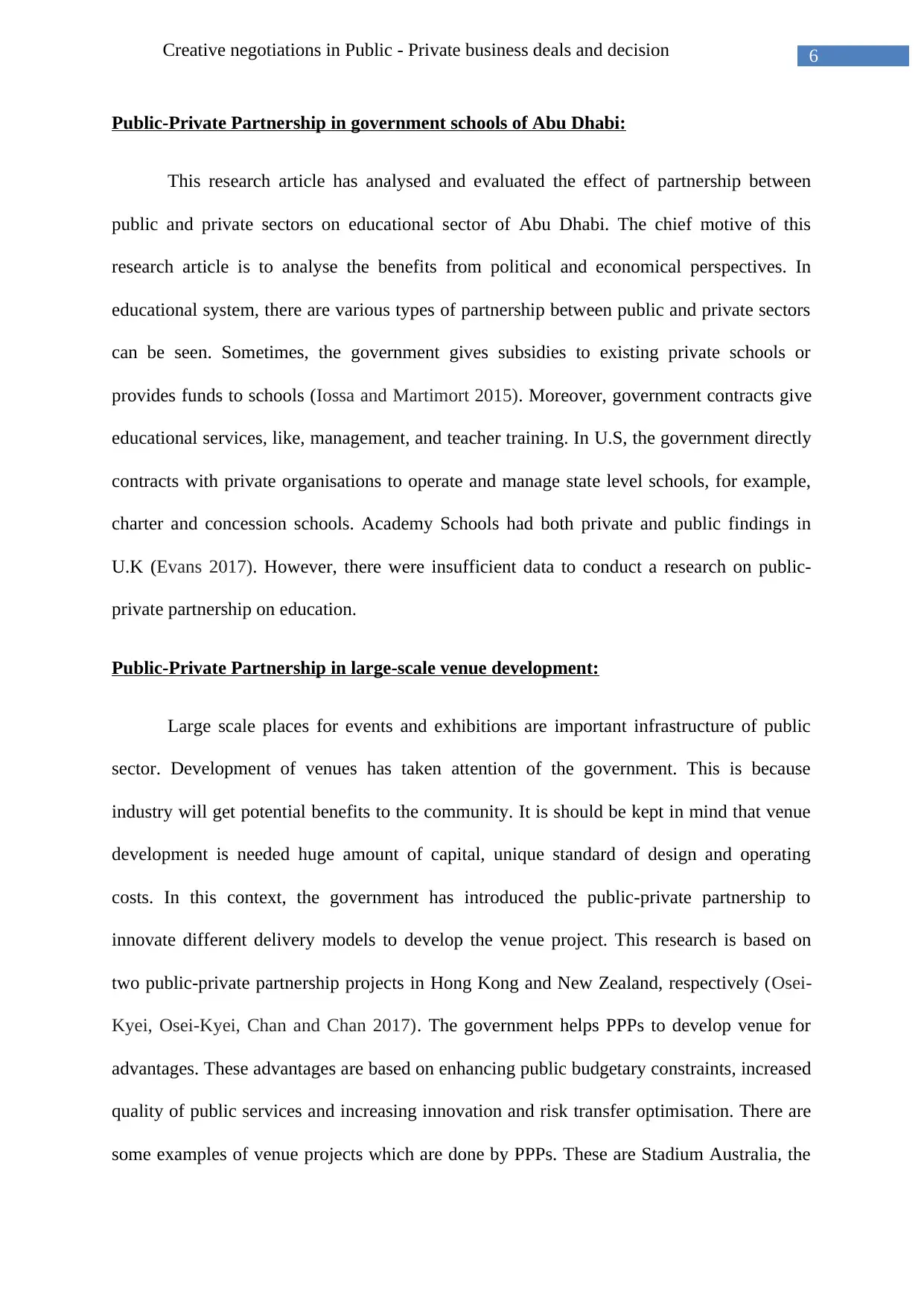
6Creative negotiations in Public - Private business deals and decision
making
Public-Private Partnership in government schools of Abu Dhabi:
This research article has analysed and evaluated the effect of partnership between
public and private sectors on educational sector of Abu Dhabi. The chief motive of this
research article is to analyse the benefits from political and economical perspectives. In
educational system, there are various types of partnership between public and private sectors
can be seen. Sometimes, the government gives subsidies to existing private schools or
provides funds to schools (Iossa and Martimort 2015). Moreover, government contracts give
educational services, like, management, and teacher training. In U.S, the government directly
contracts with private organisations to operate and manage state level schools, for example,
charter and concession schools. Academy Schools had both private and public findings in
U.K (Evans 2017). However, there were insufficient data to conduct a research on public-
private partnership on education.
Public-Private Partnership in large-scale venue development:
Large scale places for events and exhibitions are important infrastructure of public
sector. Development of venues has taken attention of the government. This is because
industry will get potential benefits to the community. It is should be kept in mind that venue
development is needed huge amount of capital, unique standard of design and operating
costs. In this context, the government has introduced the public-private partnership to
innovate different delivery models to develop the venue project. This research is based on
two public-private partnership projects in Hong Kong and New Zealand, respectively (Osei-
Kyei, Osei-Kyei, Chan and Chan 2017). The government helps PPPs to develop venue for
advantages. These advantages are based on enhancing public budgetary constraints, increased
quality of public services and increasing innovation and risk transfer optimisation. There are
some examples of venue projects which are done by PPPs. These are Stadium Australia, the
making
Public-Private Partnership in government schools of Abu Dhabi:
This research article has analysed and evaluated the effect of partnership between
public and private sectors on educational sector of Abu Dhabi. The chief motive of this
research article is to analyse the benefits from political and economical perspectives. In
educational system, there are various types of partnership between public and private sectors
can be seen. Sometimes, the government gives subsidies to existing private schools or
provides funds to schools (Iossa and Martimort 2015). Moreover, government contracts give
educational services, like, management, and teacher training. In U.S, the government directly
contracts with private organisations to operate and manage state level schools, for example,
charter and concession schools. Academy Schools had both private and public findings in
U.K (Evans 2017). However, there were insufficient data to conduct a research on public-
private partnership on education.
Public-Private Partnership in large-scale venue development:
Large scale places for events and exhibitions are important infrastructure of public
sector. Development of venues has taken attention of the government. This is because
industry will get potential benefits to the community. It is should be kept in mind that venue
development is needed huge amount of capital, unique standard of design and operating
costs. In this context, the government has introduced the public-private partnership to
innovate different delivery models to develop the venue project. This research is based on
two public-private partnership projects in Hong Kong and New Zealand, respectively (Osei-
Kyei, Osei-Kyei, Chan and Chan 2017). The government helps PPPs to develop venue for
advantages. These advantages are based on enhancing public budgetary constraints, increased
quality of public services and increasing innovation and risk transfer optimisation. There are
some examples of venue projects which are done by PPPs. These are Stadium Australia, the
Paraphrase This Document
Need a fresh take? Get an instant paraphrase of this document with our AI Paraphraser
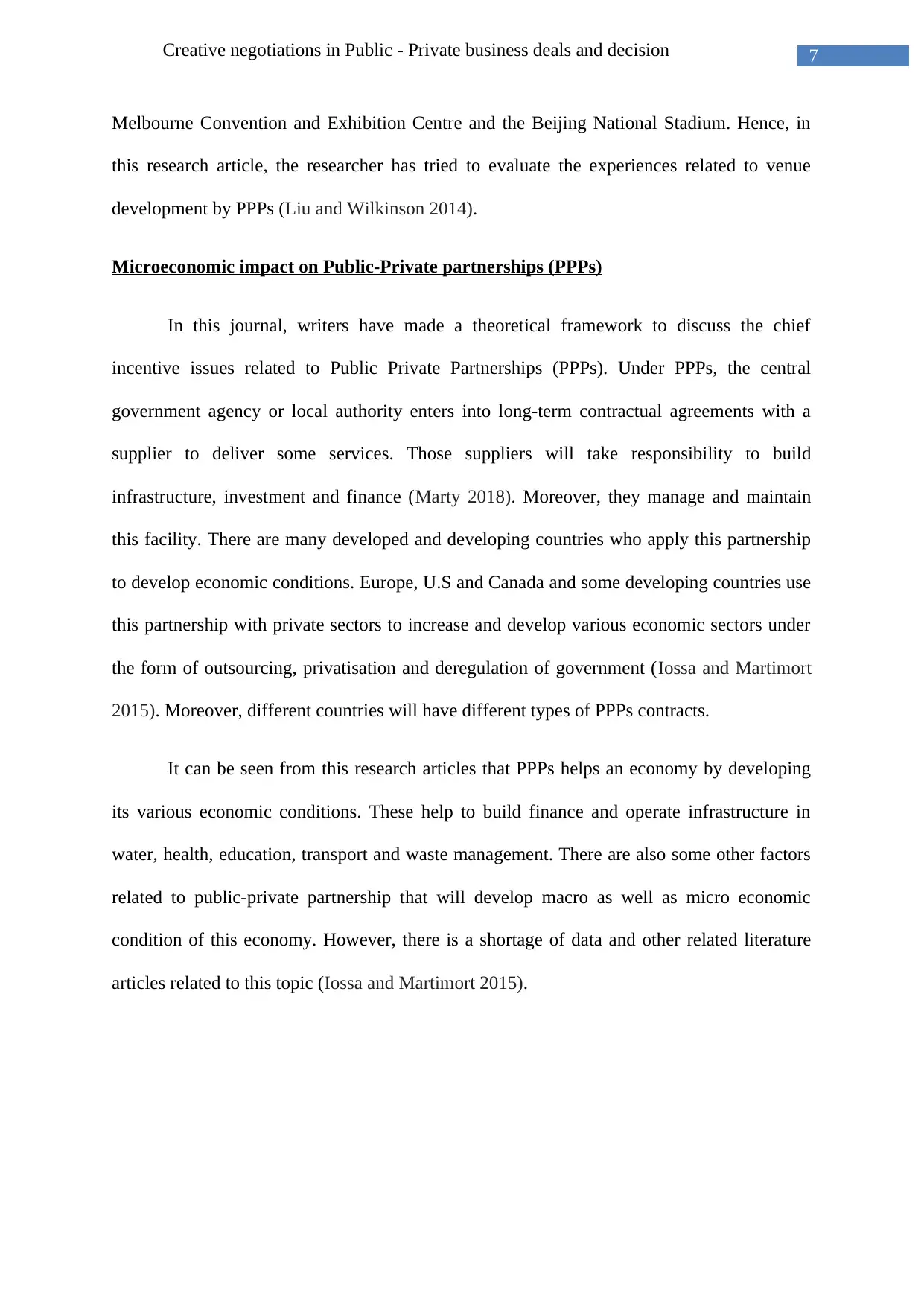
7Creative negotiations in Public - Private business deals and decision
making
Melbourne Convention and Exhibition Centre and the Beijing National Stadium. Hence, in
this research article, the researcher has tried to evaluate the experiences related to venue
development by PPPs (Liu and Wilkinson 2014).
Microeconomic impact on Public-Private partnerships (PPPs)
In this journal, writers have made a theoretical framework to discuss the chief
incentive issues related to Public Private Partnerships (PPPs). Under PPPs, the central
government agency or local authority enters into long-term contractual agreements with a
supplier to deliver some services. Those suppliers will take responsibility to build
infrastructure, investment and finance (Marty 2018). Moreover, they manage and maintain
this facility. There are many developed and developing countries who apply this partnership
to develop economic conditions. Europe, U.S and Canada and some developing countries use
this partnership with private sectors to increase and develop various economic sectors under
the form of outsourcing, privatisation and deregulation of government (Iossa and Martimort
2015). Moreover, different countries will have different types of PPPs contracts.
It can be seen from this research articles that PPPs helps an economy by developing
its various economic conditions. These help to build finance and operate infrastructure in
water, health, education, transport and waste management. There are also some other factors
related to public-private partnership that will develop macro as well as micro economic
condition of this economy. However, there is a shortage of data and other related literature
articles related to this topic (Iossa and Martimort 2015).
making
Melbourne Convention and Exhibition Centre and the Beijing National Stadium. Hence, in
this research article, the researcher has tried to evaluate the experiences related to venue
development by PPPs (Liu and Wilkinson 2014).
Microeconomic impact on Public-Private partnerships (PPPs)
In this journal, writers have made a theoretical framework to discuss the chief
incentive issues related to Public Private Partnerships (PPPs). Under PPPs, the central
government agency or local authority enters into long-term contractual agreements with a
supplier to deliver some services. Those suppliers will take responsibility to build
infrastructure, investment and finance (Marty 2018). Moreover, they manage and maintain
this facility. There are many developed and developing countries who apply this partnership
to develop economic conditions. Europe, U.S and Canada and some developing countries use
this partnership with private sectors to increase and develop various economic sectors under
the form of outsourcing, privatisation and deregulation of government (Iossa and Martimort
2015). Moreover, different countries will have different types of PPPs contracts.
It can be seen from this research articles that PPPs helps an economy by developing
its various economic conditions. These help to build finance and operate infrastructure in
water, health, education, transport and waste management. There are also some other factors
related to public-private partnership that will develop macro as well as micro economic
condition of this economy. However, there is a shortage of data and other related literature
articles related to this topic (Iossa and Martimort 2015).
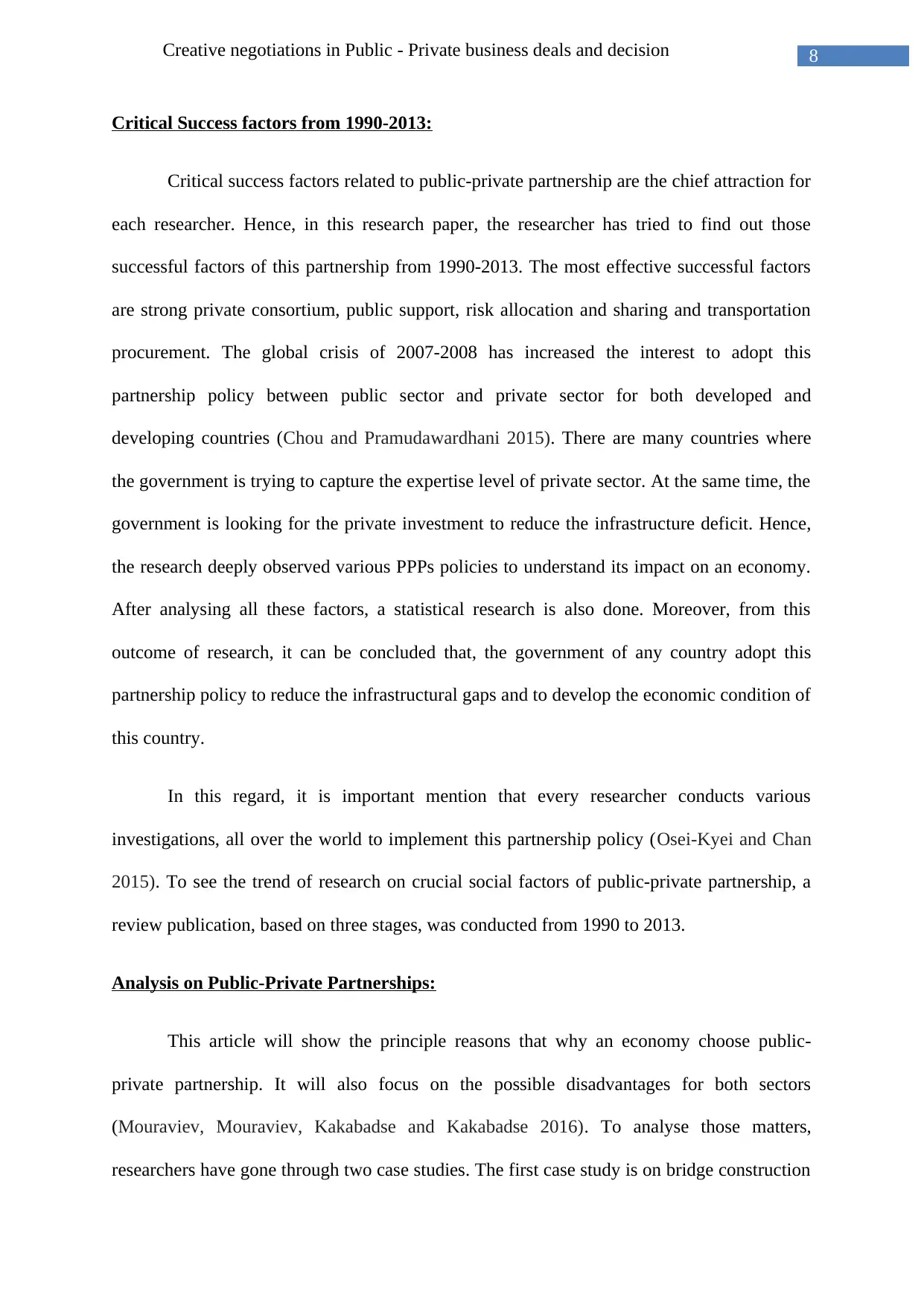
8Creative negotiations in Public - Private business deals and decision
making
Critical Success factors from 1990-2013:
Critical success factors related to public-private partnership are the chief attraction for
each researcher. Hence, in this research paper, the researcher has tried to find out those
successful factors of this partnership from 1990-2013. The most effective successful factors
are strong private consortium, public support, risk allocation and sharing and transportation
procurement. The global crisis of 2007-2008 has increased the interest to adopt this
partnership policy between public sector and private sector for both developed and
developing countries (Chou and Pramudawardhani 2015). There are many countries where
the government is trying to capture the expertise level of private sector. At the same time, the
government is looking for the private investment to reduce the infrastructure deficit. Hence,
the research deeply observed various PPPs policies to understand its impact on an economy.
After analysing all these factors, a statistical research is also done. Moreover, from this
outcome of research, it can be concluded that, the government of any country adopt this
partnership policy to reduce the infrastructural gaps and to develop the economic condition of
this country.
In this regard, it is important mention that every researcher conducts various
investigations, all over the world to implement this partnership policy (Osei-Kyei and Chan
2015). To see the trend of research on crucial social factors of public-private partnership, a
review publication, based on three stages, was conducted from 1990 to 2013.
Analysis on Public-Private Partnerships:
This article will show the principle reasons that why an economy choose public-
private partnership. It will also focus on the possible disadvantages for both sectors
(Mouraviev, Mouraviev, Kakabadse and Kakabadse 2016). To analyse those matters,
researchers have gone through two case studies. The first case study is on bridge construction
making
Critical Success factors from 1990-2013:
Critical success factors related to public-private partnership are the chief attraction for
each researcher. Hence, in this research paper, the researcher has tried to find out those
successful factors of this partnership from 1990-2013. The most effective successful factors
are strong private consortium, public support, risk allocation and sharing and transportation
procurement. The global crisis of 2007-2008 has increased the interest to adopt this
partnership policy between public sector and private sector for both developed and
developing countries (Chou and Pramudawardhani 2015). There are many countries where
the government is trying to capture the expertise level of private sector. At the same time, the
government is looking for the private investment to reduce the infrastructure deficit. Hence,
the research deeply observed various PPPs policies to understand its impact on an economy.
After analysing all these factors, a statistical research is also done. Moreover, from this
outcome of research, it can be concluded that, the government of any country adopt this
partnership policy to reduce the infrastructural gaps and to develop the economic condition of
this country.
In this regard, it is important mention that every researcher conducts various
investigations, all over the world to implement this partnership policy (Osei-Kyei and Chan
2015). To see the trend of research on crucial social factors of public-private partnership, a
review publication, based on three stages, was conducted from 1990 to 2013.
Analysis on Public-Private Partnerships:
This article will show the principle reasons that why an economy choose public-
private partnership. It will also focus on the possible disadvantages for both sectors
(Mouraviev, Mouraviev, Kakabadse and Kakabadse 2016). To analyse those matters,
researchers have gone through two case studies. The first case study is on bridge construction
⊘ This is a preview!⊘
Do you want full access?
Subscribe today to unlock all pages.

Trusted by 1+ million students worldwide
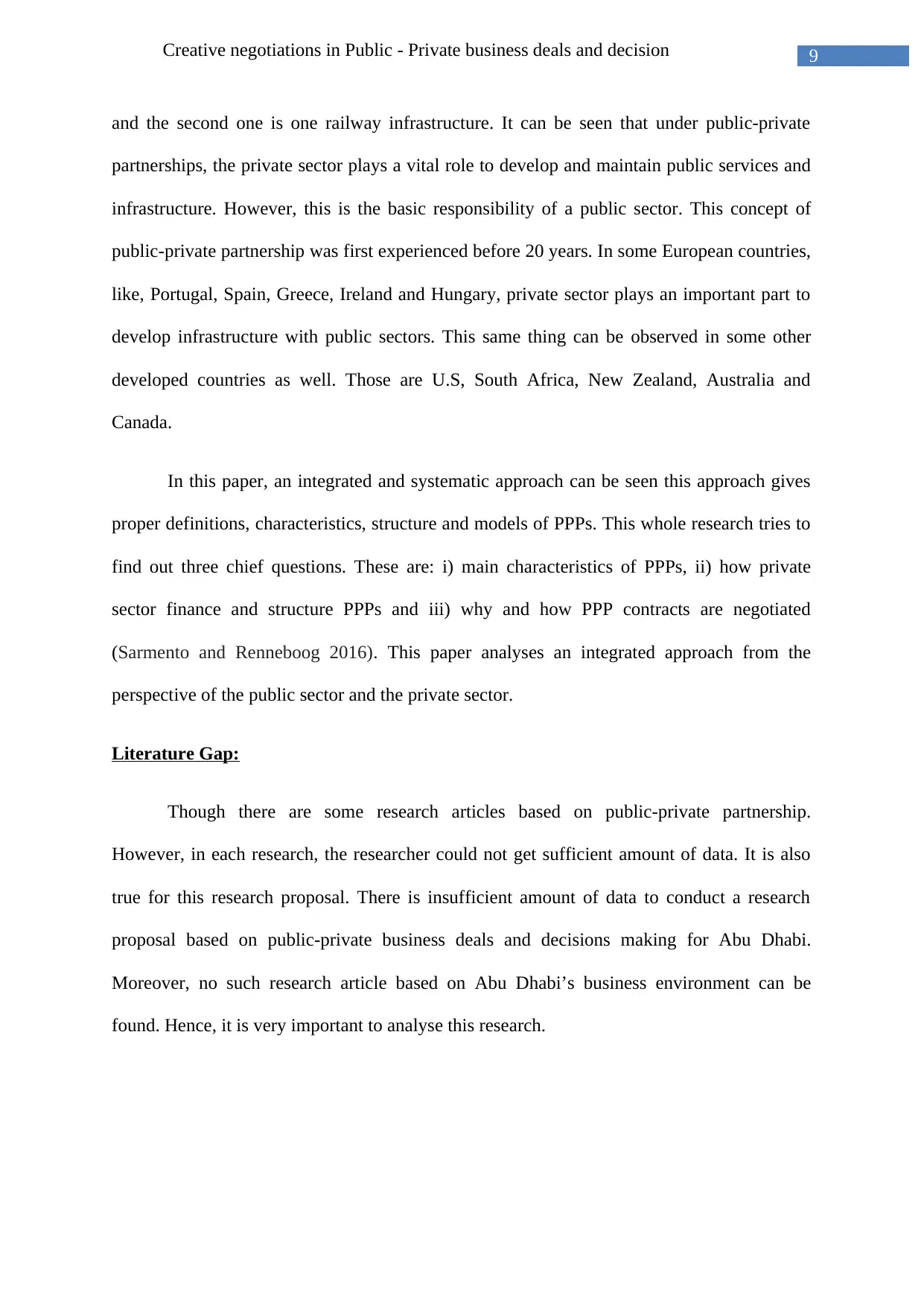
9Creative negotiations in Public - Private business deals and decision
making
and the second one is one railway infrastructure. It can be seen that under public-private
partnerships, the private sector plays a vital role to develop and maintain public services and
infrastructure. However, this is the basic responsibility of a public sector. This concept of
public-private partnership was first experienced before 20 years. In some European countries,
like, Portugal, Spain, Greece, Ireland and Hungary, private sector plays an important part to
develop infrastructure with public sectors. This same thing can be observed in some other
developed countries as well. Those are U.S, South Africa, New Zealand, Australia and
Canada.
In this paper, an integrated and systematic approach can be seen this approach gives
proper definitions, characteristics, structure and models of PPPs. This whole research tries to
find out three chief questions. These are: i) main characteristics of PPPs, ii) how private
sector finance and structure PPPs and iii) why and how PPP contracts are negotiated
(Sarmento and Renneboog 2016). This paper analyses an integrated approach from the
perspective of the public sector and the private sector.
Literature Gap:
Though there are some research articles based on public-private partnership.
However, in each research, the researcher could not get sufficient amount of data. It is also
true for this research proposal. There is insufficient amount of data to conduct a research
proposal based on public-private business deals and decisions making for Abu Dhabi.
Moreover, no such research article based on Abu Dhabi’s business environment can be
found. Hence, it is very important to analyse this research.
making
and the second one is one railway infrastructure. It can be seen that under public-private
partnerships, the private sector plays a vital role to develop and maintain public services and
infrastructure. However, this is the basic responsibility of a public sector. This concept of
public-private partnership was first experienced before 20 years. In some European countries,
like, Portugal, Spain, Greece, Ireland and Hungary, private sector plays an important part to
develop infrastructure with public sectors. This same thing can be observed in some other
developed countries as well. Those are U.S, South Africa, New Zealand, Australia and
Canada.
In this paper, an integrated and systematic approach can be seen this approach gives
proper definitions, characteristics, structure and models of PPPs. This whole research tries to
find out three chief questions. These are: i) main characteristics of PPPs, ii) how private
sector finance and structure PPPs and iii) why and how PPP contracts are negotiated
(Sarmento and Renneboog 2016). This paper analyses an integrated approach from the
perspective of the public sector and the private sector.
Literature Gap:
Though there are some research articles based on public-private partnership.
However, in each research, the researcher could not get sufficient amount of data. It is also
true for this research proposal. There is insufficient amount of data to conduct a research
proposal based on public-private business deals and decisions making for Abu Dhabi.
Moreover, no such research article based on Abu Dhabi’s business environment can be
found. Hence, it is very important to analyse this research.
Paraphrase This Document
Need a fresh take? Get an instant paraphrase of this document with our AI Paraphraser
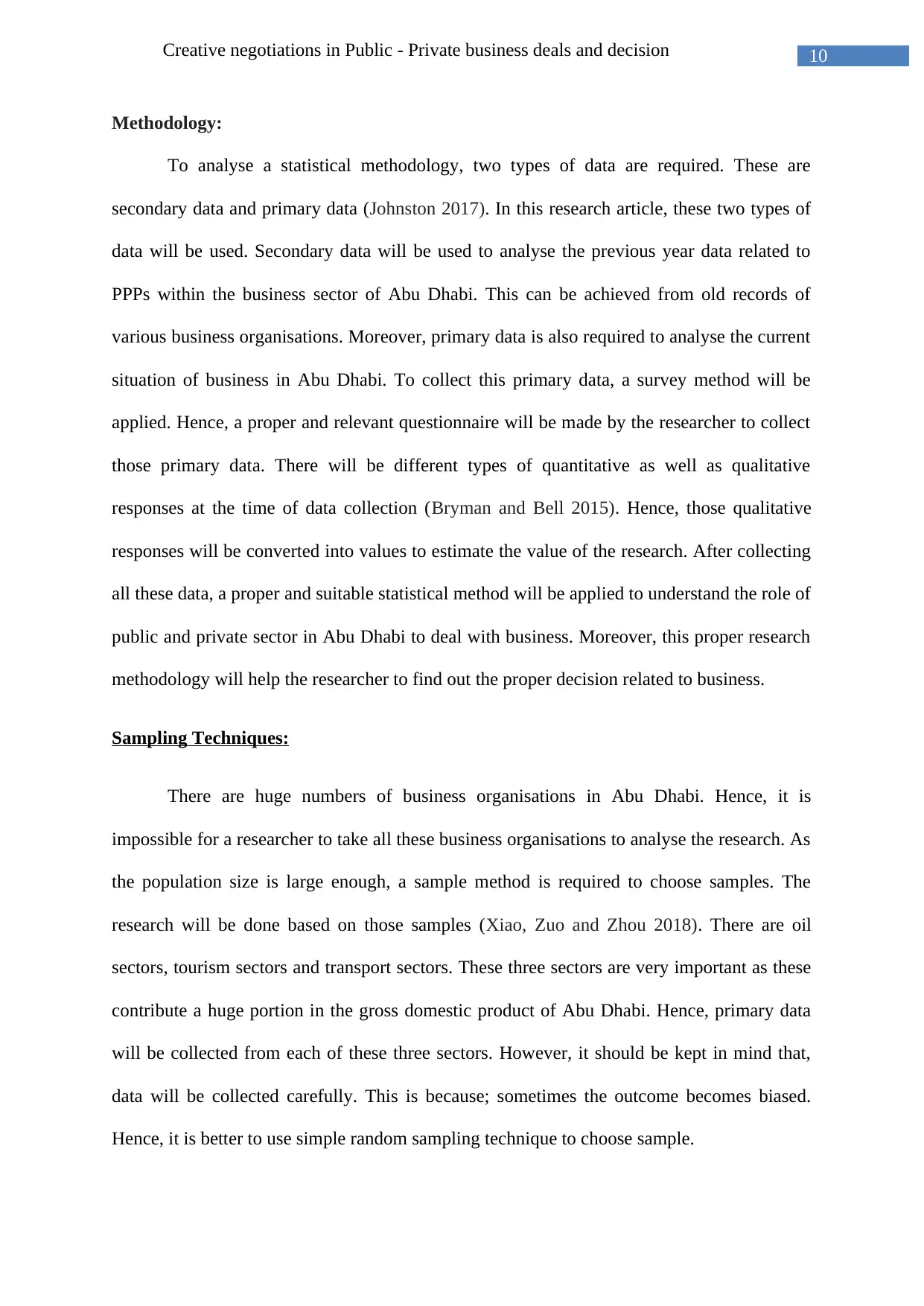
10Creative negotiations in Public - Private business deals and decision
making
Methodology:
To analyse a statistical methodology, two types of data are required. These are
secondary data and primary data (Johnston 2017). In this research article, these two types of
data will be used. Secondary data will be used to analyse the previous year data related to
PPPs within the business sector of Abu Dhabi. This can be achieved from old records of
various business organisations. Moreover, primary data is also required to analyse the current
situation of business in Abu Dhabi. To collect this primary data, a survey method will be
applied. Hence, a proper and relevant questionnaire will be made by the researcher to collect
those primary data. There will be different types of quantitative as well as qualitative
responses at the time of data collection (Bryman and Bell 2015). Hence, those qualitative
responses will be converted into values to estimate the value of the research. After collecting
all these data, a proper and suitable statistical method will be applied to understand the role of
public and private sector in Abu Dhabi to deal with business. Moreover, this proper research
methodology will help the researcher to find out the proper decision related to business.
Sampling Techniques:
There are huge numbers of business organisations in Abu Dhabi. Hence, it is
impossible for a researcher to take all these business organisations to analyse the research. As
the population size is large enough, a sample method is required to choose samples. The
research will be done based on those samples (Xiao, Zuo and Zhou 2018). There are oil
sectors, tourism sectors and transport sectors. These three sectors are very important as these
contribute a huge portion in the gross domestic product of Abu Dhabi. Hence, primary data
will be collected from each of these three sectors. However, it should be kept in mind that,
data will be collected carefully. This is because; sometimes the outcome becomes biased.
Hence, it is better to use simple random sampling technique to choose sample.
making
Methodology:
To analyse a statistical methodology, two types of data are required. These are
secondary data and primary data (Johnston 2017). In this research article, these two types of
data will be used. Secondary data will be used to analyse the previous year data related to
PPPs within the business sector of Abu Dhabi. This can be achieved from old records of
various business organisations. Moreover, primary data is also required to analyse the current
situation of business in Abu Dhabi. To collect this primary data, a survey method will be
applied. Hence, a proper and relevant questionnaire will be made by the researcher to collect
those primary data. There will be different types of quantitative as well as qualitative
responses at the time of data collection (Bryman and Bell 2015). Hence, those qualitative
responses will be converted into values to estimate the value of the research. After collecting
all these data, a proper and suitable statistical method will be applied to understand the role of
public and private sector in Abu Dhabi to deal with business. Moreover, this proper research
methodology will help the researcher to find out the proper decision related to business.
Sampling Techniques:
There are huge numbers of business organisations in Abu Dhabi. Hence, it is
impossible for a researcher to take all these business organisations to analyse the research. As
the population size is large enough, a sample method is required to choose samples. The
research will be done based on those samples (Xiao, Zuo and Zhou 2018). There are oil
sectors, tourism sectors and transport sectors. These three sectors are very important as these
contribute a huge portion in the gross domestic product of Abu Dhabi. Hence, primary data
will be collected from each of these three sectors. However, it should be kept in mind that,
data will be collected carefully. This is because; sometimes the outcome becomes biased.
Hence, it is better to use simple random sampling technique to choose sample.
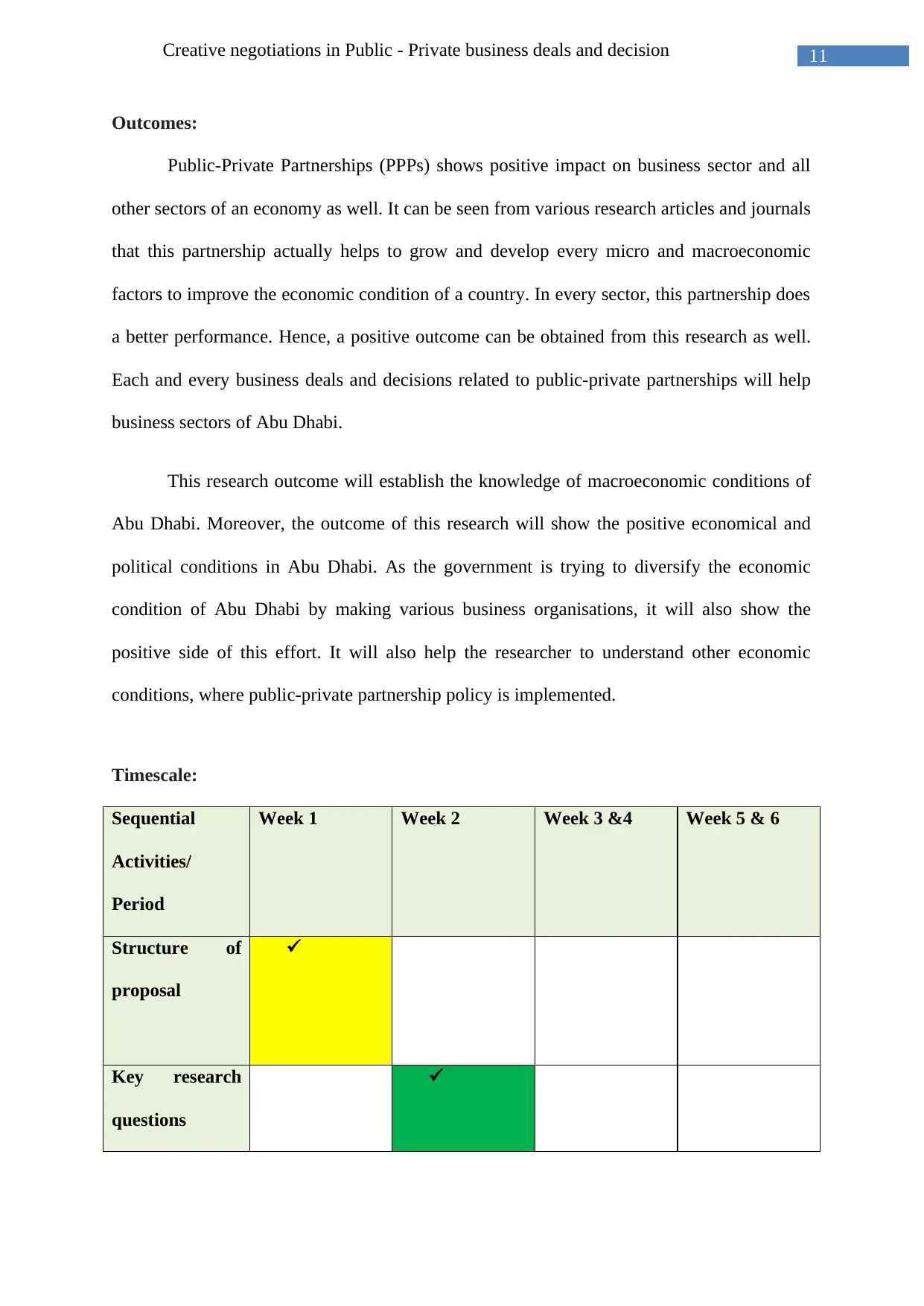
11Creative negotiations in Public - Private business deals and decision
making
Outcomes:
Public-Private Partnerships (PPPs) shows positive impact on business sector and all
other sectors of an economy as well. It can be seen from various research articles and journals
that this partnership actually helps to grow and develop every micro and macroeconomic
factors to improve the economic condition of a country. In every sector, this partnership does
a better performance. Hence, a positive outcome can be obtained from this research as well.
Each and every business deals and decisions related to public-private partnerships will help
business sectors of Abu Dhabi.
This research outcome will establish the knowledge of macroeconomic conditions of
Abu Dhabi. Moreover, the outcome of this research will show the positive economical and
political conditions in Abu Dhabi. As the government is trying to diversify the economic
condition of Abu Dhabi by making various business organisations, it will also show the
positive side of this effort. It will also help the researcher to understand other economic
conditions, where public-private partnership policy is implemented.
Timescale:
Sequential
Activities/
Period
Week 1 Week 2 Week 3 &4 Week 5 & 6
Structure of
proposal
Key research
questions
making
Outcomes:
Public-Private Partnerships (PPPs) shows positive impact on business sector and all
other sectors of an economy as well. It can be seen from various research articles and journals
that this partnership actually helps to grow and develop every micro and macroeconomic
factors to improve the economic condition of a country. In every sector, this partnership does
a better performance. Hence, a positive outcome can be obtained from this research as well.
Each and every business deals and decisions related to public-private partnerships will help
business sectors of Abu Dhabi.
This research outcome will establish the knowledge of macroeconomic conditions of
Abu Dhabi. Moreover, the outcome of this research will show the positive economical and
political conditions in Abu Dhabi. As the government is trying to diversify the economic
condition of Abu Dhabi by making various business organisations, it will also show the
positive side of this effort. It will also help the researcher to understand other economic
conditions, where public-private partnership policy is implemented.
Timescale:
Sequential
Activities/
Period
Week 1 Week 2 Week 3 &4 Week 5 & 6
Structure of
proposal
Key research
questions
⊘ This is a preview!⊘
Do you want full access?
Subscribe today to unlock all pages.

Trusted by 1+ million students worldwide
1 out of 15
Related Documents
Your All-in-One AI-Powered Toolkit for Academic Success.
+13062052269
info@desklib.com
Available 24*7 on WhatsApp / Email
![[object Object]](/_next/static/media/star-bottom.7253800d.svg)
Unlock your academic potential
Copyright © 2020–2025 A2Z Services. All Rights Reserved. Developed and managed by ZUCOL.





